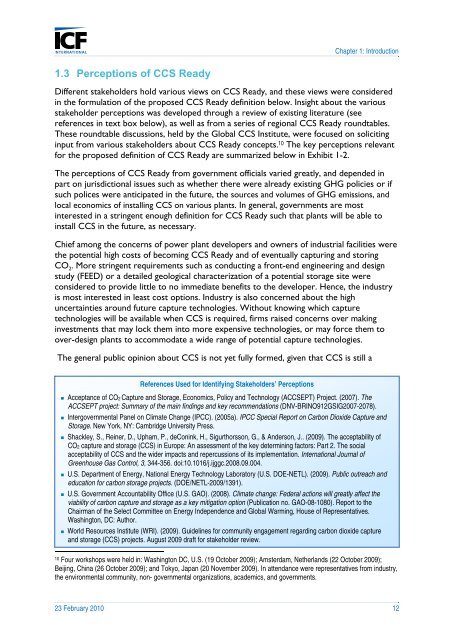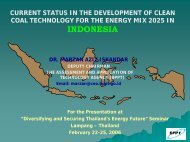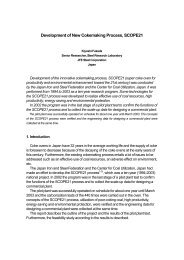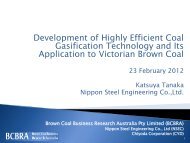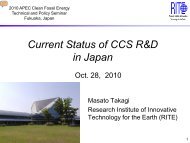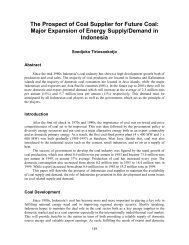Defining CCS Ready: An Approach to An International Definition
Defining CCS Ready: An Approach to An International Definition
Defining CCS Ready: An Approach to An International Definition
- No tags were found...
Create successful ePaper yourself
Turn your PDF publications into a flip-book with our unique Google optimized e-Paper software.
Chapter 1: Introduction1.3 Perceptions of <strong>CCS</strong> <strong>Ready</strong>Different stakeholders hold various views on <strong>CCS</strong> <strong>Ready</strong>, and these views were consideredin the formulation of the proposed <strong>CCS</strong> <strong>Ready</strong> definition below. Insight about the variousstakeholder perceptions was developed through a review of existing literature (seereferences in text box below), as well as from a series of regional <strong>CCS</strong> <strong>Ready</strong> roundtables.These roundtable discussions, held by the Global <strong>CCS</strong> Institute, were focused on solicitinginput from various stakeholders about <strong>CCS</strong> <strong>Ready</strong> concepts. 10 The key perceptions relevantfor the proposed definition of <strong>CCS</strong> <strong>Ready</strong> are summarized below in Exhibit 1-2.The perceptions of <strong>CCS</strong> <strong>Ready</strong> from government officials varied greatly, and depended inpart on jurisdictional issues such as whether there were already existing GHG policies or ifsuch polices were anticipated in the future, the sources and volumes of GHG emissions, andlocal economics of installing <strong>CCS</strong> on various plants. In general, governments are mostinterested in a stringent enough definition for <strong>CCS</strong> <strong>Ready</strong> such that plants will be able <strong>to</strong>install <strong>CCS</strong> in the future, as necessary.Chief among the concerns of power plant developers and owners of industrial facilities werethe potential high costs of becoming <strong>CCS</strong> <strong>Ready</strong> and of eventually capturing and s<strong>to</strong>ringCO 2 . More stringent requirements such as conducting a front-end engineering and designstudy (FEED) or a detailed geological characterization of a potential s<strong>to</strong>rage site wereconsidered <strong>to</strong> provide little <strong>to</strong> no immediate benefits <strong>to</strong> the developer. Hence, the industryis most interested in least cost options. Industry is also concerned about the highuncertainties around future capture technologies. Without knowing which capturetechnologies will be available when <strong>CCS</strong> is required, firms raised concerns over makinginvestments that may lock them in<strong>to</strong> more expensive technologies, or may force them <strong>to</strong>over-design plants <strong>to</strong> accommodate a wide range of potential capture technologies.The general public opinion about <strong>CCS</strong> is not yet fully formed, given that <strong>CCS</strong> is still aReferences Used for Identifying Stakeholders’ Perceptions• Acceptance of CO2 Capture and S<strong>to</strong>rage, Economics, Policy and Technology (A<strong>CCS</strong>EPT) Project. (2007). TheA<strong>CCS</strong>EPT project: Summary of the main findings and key recommendations (DNV-BRINO912GSIG2007-2078).• Intergovernmental Panel on Climate Change (IPCC). (2005a). IPCC Special Report on Carbon Dioxide Capture andS<strong>to</strong>rage. New York, NY: Cambridge University Press.• Shackley, S., Reiner, D., Upham, P., deConink, H., Sigurthorsson, G., & <strong>An</strong>derson, J.. (2009). The acceptability ofCO2 capture and s<strong>to</strong>rage (<strong>CCS</strong>) in Europe: <strong>An</strong> assessment of the key determining fac<strong>to</strong>rs: Part 2. The socialacceptability of <strong>CCS</strong> and the wider impacts and repercussions of its implementation. <strong>International</strong> Journal ofGreenhouse Gas Control, 3, 344-356. doi:10.1016/j.ijggc.2008.09.004.• U.S. Department of Energy, National Energy Technology Labora<strong>to</strong>ry (U.S. DOE-NETL). (2009). Public outreach andeducation for carbon s<strong>to</strong>rage projects. (DOE/NETL-2009/1391).• U.S. Government Accountability Office (U.S. GAO). (2008). Climate change: Federal actions will greatly affect theviability of carbon capture and s<strong>to</strong>rage as a key mitigation option (Publication no. GAO-08-1080). Report <strong>to</strong> theChairman of the Select Committee on Energy Independence and Global Warming, House of Representatives.Washing<strong>to</strong>n, DC: Author.• World Resources Institute (WRI). (2009). Guidelines for community engagement regarding carbon dioxide captureand s<strong>to</strong>rage (<strong>CCS</strong>) projects. August 2009 draft for stakeholder review.10 Four workshops were held in: Washing<strong>to</strong>n DC, U.S. (19 Oc<strong>to</strong>ber 2009); Amsterdam, Netherlands (22 Oc<strong>to</strong>ber 2009);Beijing, China (26 Oc<strong>to</strong>ber 2009); and Tokyo, Japan (20 November 2009). In attendance were representatives from industry,the environmental community, non- governmental organizations, academics, and governments.23 February 2010 12


